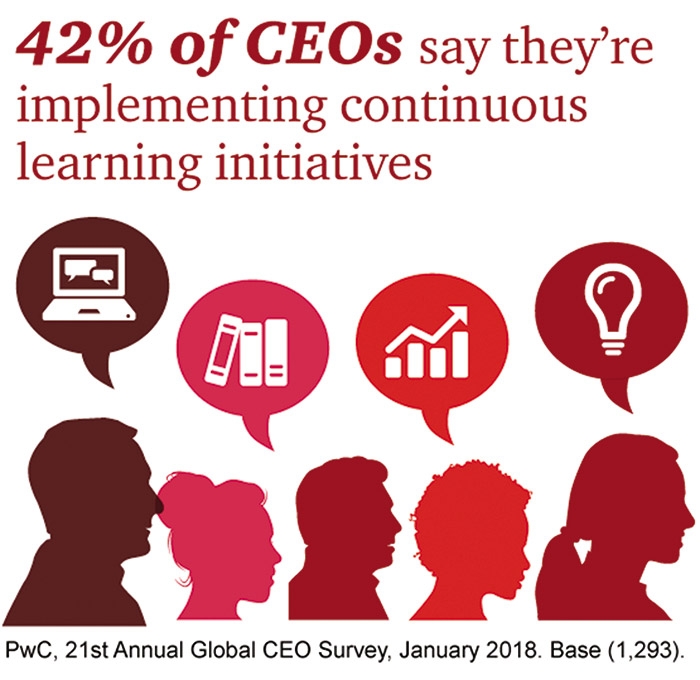Get started on reskilling workforce
 |
New jobs, new skills
 |
As the world dives deeper into the digital age, technologies such as robotics, artificial intelligence, and Big Data are drastically transforming the labour market. Demands for manual and unskilled work will gradually decline due to automation. At the same time, many new jobs with fundamentally different skill requirements will come into existence.
There will be an increased demand for STEM (science, technology, engineering, and mathematics) skills as companies will need people who can understand how to use automation tools and make sense of Big Data. In addition, experts forecast that while simple tasks can be automated, soft skills that cannot be performed by machines will still be sought. Uniquely human traits like emotional intelligence, creativity, and persuasion will become more valuable. This also means that the required skill set for the same job can be very different in the future.
Overall, companies in Vietnam as well as around the globe are struggling to fill their skills demands in the digital age: 80 per cent of CEOs say they are concerned about the availability of the key skills needed to succeed in the digital economy, according to PwC’s 2018 Global CEO Survey. Moreover, there is a lack of clarity regarding the required skills to succeed under the Fourth Industrial Revolution. PwC’s Industry 4.0 Vietnam Survey 2018 finds that only 14 per cent of respondents have a clear view of the skills required for digital transformation, while 16 per cent of respondents indicated that they had no idea at all about the skills and capabilities required.
What can leaders do?
Any effort to build the workforce of tomorrow would need to start from the companies themselves. The top tasks are to identify talent gaps and conduct re-skilling of the workforce. Increased business investment in employees’ continuous learning will be key to ensure that the workforce remains competitive and can adapt to new technologies. PwC’s researchers have laid out the five steps to help companies get their own initiative started.
- Assess where you are and where you need to go
Before you can begin to plan ahead, you need to know what skills your people have now. These skills can be categorised by function and level of expertise.
Next, try to determine the skills your company will need two to five years down the road, and identify gaps between your current state and future goals. Based on that knowledge, you will be able to start devising an appropriate strategy for recruitment and people development.
- Advance your workforce
Once you have an overall understanding of skills, communicate it to your workforce so that each employee understands where they are now against the future skills they will need to master. Companies should sponsor learning and development programmes that allow for individualised journeys. By pairing learning with regular coaching, managers and their employees can sustain the learning momentum and reduce the risk that the reskilling efforts will be abandoned.
- Integrate new talent
Productivity and innovation may mean bringing in new talent for your workforce. Hiring experienced people with diverse skills and backgrounds can transform the way work gets done in your business. They can bring new ways of thinking, help speed up change, and promote innovation across the organisation. However, business leaders should ensure that the talent pool is aligned with the business objectives and only hire accordingly.
- Keep up with innovation
To truly accelerate skill change, companies need to create new spaces and new experiences. More companies are experimenting with incubator or accelerator programmes, where individuals with diverse skills and mindsets come together to examine the real challenges the organisation faces and create totally new solutions to apply in their work with clients, suppliers, and business partners. Other companies are modernising the work environment, giving them flexible ways of working and new opportunities to practice skills that their organisations value.
- Get others on your side
At the same time as making their own efforts, business leaders should engage academic institutions and policymakers as reskilling workers will require help from them.
Company leaders should actively engage in policy discussions to promote incentives aimed at encouraging workers’ mobility and development of skills. For many workers, job mobility, retraining, and rotation will become a key way to improve their employability. However, many people feel restricted to stay in their current job because the compensation and benefits policies in their organisation or country do not allow for mobility.
On the education side, companies should build partnerships with schools and universities to help revise curricula and create opportunities for lifelong learning. To create a talent pipeline for future workers, more apprenticeship or internship opportunities should be developed.
One important thing to note is that the workforce transformation should be continually monitored and revised. As you progress, remember to ask yourself: How is your staff changing? And how are your needs changing? Based on that, you can reshape the opportunities for your people to apply new skills, in new ways.
By Dinh Thi Quynh Van General director, PwC Vietnam
What the stars mean:
★ Poor ★ ★ Promising ★★★ Good ★★★★ Very good ★★★★★ Exceptional
Related Contents
Latest News
More News
- Pivotal stage of growth paves way for rise in M&As (December 03, 2025 | 10:00)
- Positive projections for M&A interest from Thailand (December 03, 2025 | 09:40)
- Manifesting the first line of defence in cybersecurity (December 03, 2025 | 09:00)
- The transformational role AI can play in accounting arena (December 03, 2025 | 08:00)
- Unlocking 5G-AI potential in Singapore (December 03, 2025 | 08:00)
- Data-driven strategies vital for a fast-evolving nation (December 02, 2025 | 09:41)
- Policy to practice: how Vietnam can lead the region (November 26, 2025 | 16:03)
- Mobilising private capital at scale vital for climate battle (November 26, 2025 | 15:36)
- VILAF and Yoon & Yang launch Vietnam - Korea Practice Unit (November 26, 2025 | 15:16)
- Trademark disputes challenge foreign firms in Vietnam (November 24, 2025 | 15:30)

 Tag:
Tag:




















 Mobile Version
Mobile Version